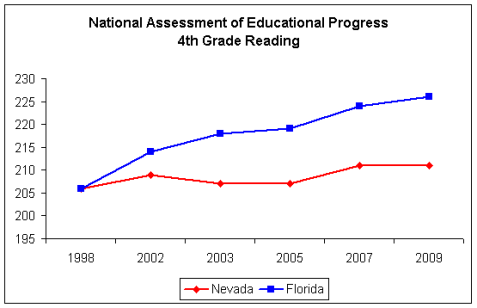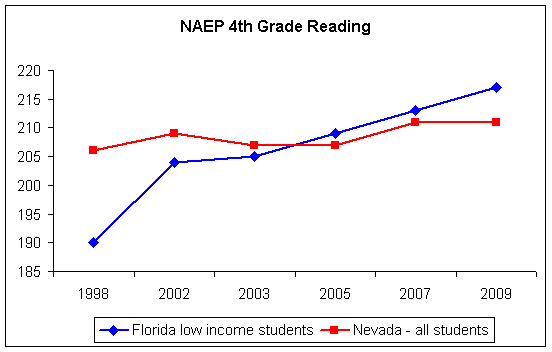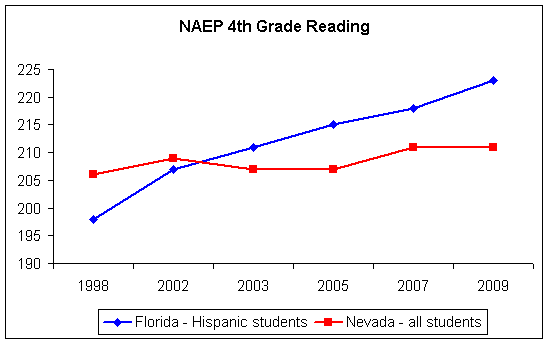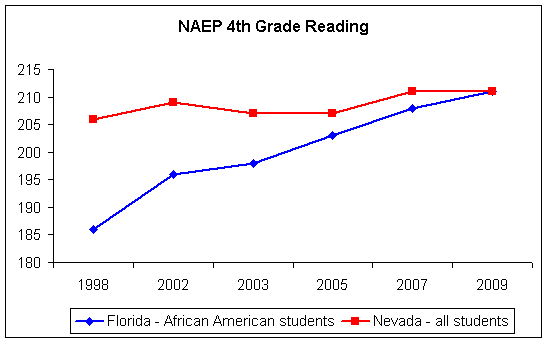Why Florida succeeds where Nevada fails
Florida and Nevada have many similarities. Both are sunny tourist states with large minority populations. Both states spend less on K-12 education, on average, than do other states. And, back in 1998, students of both states performed at thoroughly pedestrian levels on the National Assessment of Educational Progress.
A decade later, we see the two states embarked upon different paths.
The result? Student achievement in math and reading has exploded upward in Florida, while in Nevada it continues to merely stagnate.
The dramatic results are apparent in NAEP's report on fourth-grade English reading. Reading is crucial, because students who fail to learn to read will struggle and become more likely to drop out.
In 1998, Florida's and Nevada's students both scored 206 on the NAEP reading exam. By 2009, Nevada had improved only marginally, to 211. Florida, however, was running up the score at 226 — meaning that the average fourth-grade student in Florida was now more than an entire grade level ahead of his or her Nevada counterpart.

Important subgroups in Florida — Hispanics, African-Americans and low-income students (i.e., those in a family of four earning under $38,000 annually) — also saw tremendous achievement gains. The improvement is so dramatic that Florida's Hispanic students now outscore Nevada's white students on the fourth-grade English reading exam!
In fact, the average Hispanic student in Florida ties or outscores the statewide average for all students in 30 states — Alabama, Alaska, Arkansas, Arizona, California, Georgia, Hawaii, Idaho, Illinois, Indiana, Iowa, Louisiana, Michigan, Minnesota, Mississippi, Nebraska, Nevada, New Mexico, North Carolina, Oklahoma, Oregon, Rhode Island, South Carolina, South Dakota, Tennessee, Texas, Utah, Washington, Wisconsin and Wyoming.
Idaho, Indiana, Minnesota, Nebraska, Oregon, South Dakota, Utah, Wisconsin and Wyoming are especially notable, as these states are all more than 80 percent white, non-Hispanic. Reality refutes the apologists for U.S. public-education failure who scapegoat minority students, asserting they handicap public schools. In fact, Florida's African-American students now tie or outscore the average student in eight states — those of Alaska, Arizona, California, Hawaii, Louisiana, Mississippi, Nevada and New Mexico.
Florida's low-income students are also performing well — tying or outscoring all students, on average, in 14 states, including Nevada. Embarrassingly, Florida's low-income fourth-grade students are a half-grade level ahead of the average student in the Silver State.
Why was Florida able to improve student achievement across the board, and in the traditionally "underserved" communities?
Contrary to the constant refrain coming from Nevada's tax-consuming interest groups, spending more money was not the answer. The latest data from the U.S. Department of Education tells us that, between 1997-98 and 2006-07, per-pupil state spending, in inflation-adjusted dollars, increased by an average of $1,983 nationwide. That is 53 percent more than in Florida, where spending increased by just $1,298 per pupil.
Florida increased per-pupil spending by a mere $152 more than Nevada — yet Florida's students are an entire grade-level ahead. And while Hawaii increased spending by $4,144 and Wyoming increased spending by $5,953, neither state outperforms Florida's Hispanic students on the crucial fourth-grade NAEP reading exam. In fact, Florida ranks sixth in the nation on that exam, even though 35 states spend more.
What's the secret behind Florida's jump in student achievement? Education reform — on multiple fronts:
- Florida has the largest virtual-school program in the nation, with more than 80,000 students learning online.
- The state has a robust program of charter schools (autonomous, privately run public schools): Over 350 charter schools serve more than 100,000 students.
- Florida created a corporate-tuition scholarship program that allows more than 23,000 low-income students to attend the school of their parents' choice.
- Florida operates the McKay Scholarship program, which sends over 20,000 special-needs kids to the public or private school of their parents' choice.
- Florida strengthened curriculum and assessments and introduced a very clear and public system for grading schools: A through F.
- Florida banned social promotion out of the third grade — if the child cannot yet read, he or she repeats the grade or takes a remedial summer-school program.
- Florida reformed teacher recruitment by creating a genuine alternative pathway, in which adult professionals who desire to teach can become state-certified.
- Florida even, for a time, offered students scholarships to leave failing schools.
No single silver bullet exists for improving education, but this cocktail of reforms has produced amazing results for Florida students across the board.
Unfortunately, in Nevada, state lawmakers have wasted yet another decade because they failed to take the steps necessary for educational improvement. We can hope the appropriate action will be taken in 2011, but for many students, tragically, it is already too late.

*Florida's low-income students outscore the average of all Nevada students.

*Florida's Hispanic students outscore the average of all Nevada students.

*Florida's African American students now tie the average of all Nevada students.
Patrick R. Gibbons is an education policy analyst at the Nevada Policy Research Institute. For more visit http://npri.org/.
Read more: